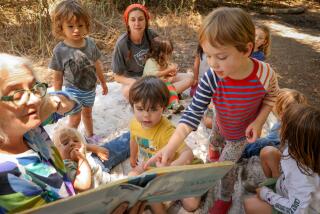Australian Students Wired for Learning in Outback
- Share via
BROKEN HILL, Australia — Kindergarten teacher Judy Woodhill starts her class with a cheery greeting: “Good morning, Paddington Bears. Are you well this morning?”
“Good morning--over!” a dozen voices reply, crackling with static as they boom from the loudspeakers in Woodhill’s classroom, the Outback radio base station of Broken Hill’s School of the Air.
The class motto is “The Sky Is the Roof of Our School,” appropriately enough, because the school’s 87 primary students live on isolated ranches spread over 193,000 square miles of red-dirt desert and scrubland in western New South Wales.
From each farm, each pupil checks in daily by radio--”Good morning, Jake in Pineview”; “Good morning, Ben at Fowler’s Gap”--before they get down to the day’s on-air lesson.
The radio contact breaks the isolation of these children scattered through the Outback, building friendships among them as well as providing long-distance education.
Today, Woodhill has her students color the oceans blue on world maps they received in the mail. Then she reads them a story about a boy who sells newspapers from the Bondi streetcar in Sydney--punctuated with dramatic pauses and questions about what they think will happen next.
Each daily radio lesson lasts only half an hour. Each child spends at least four hours on homework, taught and supervised by a parent or a tutor hired by the ranch owner.
Broken Hill’s program has about 30 tutors serving as on-site teachers. About 10 of them used to be teachers in big cities.
The School of the Air students “come out well on top of the state average” on the New South Wales basic school tests, administrator Geoff Brown says. “They’re not in a situation where there’s one teacher and 30 students.”
Hiring a tutor allows the parents to concentrate on the ranch or farm work, which can be from dawn to dusk in busy seasons.
Even the students are sometimes “absent” during floods, droughts or sheep-shearing time.
Their homework and art projects are mailed to Broken Hill to be graded and evaluated, which also gives teachers a chance to compliment the children’s work over the air--when the whole class can hear.
The teachers also visit each of their School of the Air students once a year, staying a day or more to instruct and evaluate the pupil and counsel the tutor. If the family comes to Broken Hill for supplies, the kids come too and temporarily join the regular class in town.
Students also gather each year in Broken Hill for a class reunion.
New South Wales has 13 “distance education” schools teaching by correspondence, radio or visits by roving teachers. About 640 students get lessons by radio.
Elsewhere in Australia, radio classes enroll 300 primary students in Western Australia state, 135 in South Australia, 1,655 in Queensland and 360 in the Northern Territory.
The programs are completely government supported. Even the radio equipment is provided on loan to the Outback families by the school system.
Schools of the Air evolved from the radio network set up in the 1930s among Outback ranches and towns by the Flying Doctor services. The Alice Springs school was founded in 1951; the Broken Hill school in 1956.
The primary students on Outback ranches actually make up only 40% of Australia’s “distance” students.
The other 60% are pupils living on fishing boats or yachts; children traveling with parents who are on sabbatical or moving to new jobs in another part of the country; teenagers in jail; adults in isolated regions; people who are bedridden by illness or injuries; and even some students overseas who stay in touch with their teacher and classmates by radio and mail.
More to Read
Sign up for Essential California
The most important California stories and recommendations in your inbox every morning.
You may occasionally receive promotional content from the Los Angeles Times.









